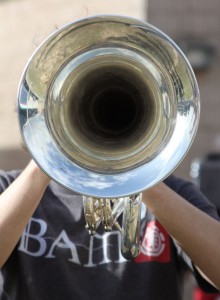
University of Miami professor’s study examines who’s in the band
Here’s an interesting piece of research, courtesy of the University of Miami’s Carlos Abril, who directs the undergraduate music education department at the college. In a study just published in the “Journal of Research in Music Education,” Abril and co-author Kenneth Elpus of the University of Maryland found that, as of 2004, about 21 percent of all high school seniors in the country were participating in school music ensembles. That presents a decline of about 10 percent from 1982, according to the study.
More importantly, the demographic makeup of those students tended to be whiter and more privileged than other segments of the student population of high school seniors. Hispanics in particular were underrepresented, the researchers found.
“We both approached this with very open minds, to let the data speak to us,” Abril said. “It seemed to us that the schools were changing drastically, but to our eyes the ensemble situation seemed much the same.”
Why aren’t Hispanics as interested in band, orchestra and chorus as the other kids? Abril suggests two reasons generated by his research.
“Part of it is not having enough role models,” he said, which puts the onus on educators and universities to reach out to underrepresented populations. “The other thing is that many of the Hispanic students are English-language learners who need special courses to learn English. That steers them into extra courses, and that doesn’t give them the opportunity to study music in the program.”
And that distances them from the activities.
“There has been a discussion about whether band, choir or orchestras are somewhat irrelevant,” Abril said. “It may have a lot to do with the language barrier … parents and students may feel left out, not knowing and not understanding the music program.” Then again, it may be that the students need to be reached a different way.
“It may have to do with the way we offer the courses … band and orchestra may not have the social capital it once did,” Abril said.
The results of the study are telling, if not all that surprising for those of us who’ve followed these things or have high school ensemble experience. Female students comprise the majority of seniors in music, at 61 percent, and nearly 80 percent of ensemble players or singers came from intact two-parent homes. Almost a third of these students came from the highest socioeconomic stratum.
The bulk of the students (65.7 percent) were white, followed by African-Americans (15.2 percent), Hispanics (10.2 percent), multiracial students (4.3 percent) and Asians (3.8 percent), according to the study. Overall, “music students are not a representative subset of the population of U.S. high school students,” the paper notes.
That buttresses the idea that the arts are elite, though not elitist, occupations. And while Abril and Elpus’ study takes pains to point out the research that has linked music and arts participation with higher achievement later in life, they also list other data that indicates people from more comfortable backgrounds participate more in extracurricular activities in general.
But Abril doesn’t see a bowling-alone sort of future for students who aren’t reached by today’s music programs.
“I’m optimistic,” he said, adding that when he first assembled his conclusions, “21 percent seemed healthy to me.” Even so, there’s room for improvement, and he sees this demographic profile as a way to suggest more reaching out on the part of music educators.
“How can we make school music more real for more students?” he asked. “We should be proactive about it, and we should start rethinking the way we offer music in the schools.”
Recent Content
-
Artsarticle ·
-
Artsarticle ·
-
Artsarticle ·
